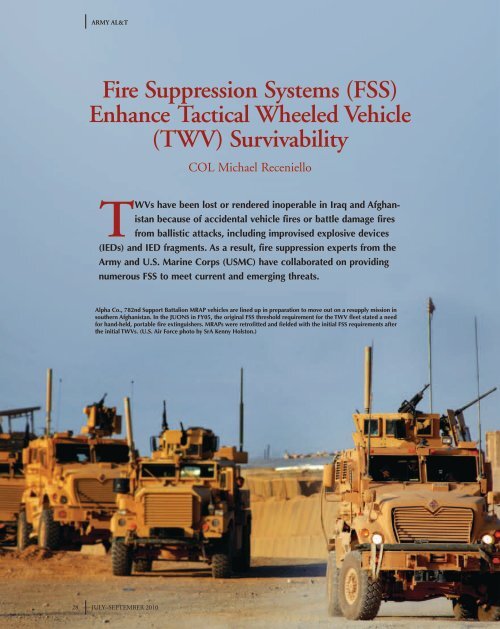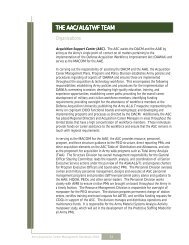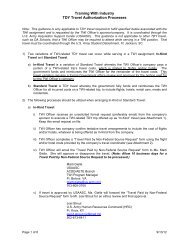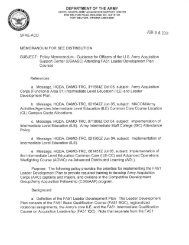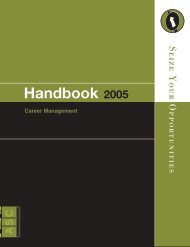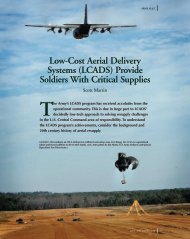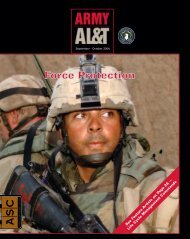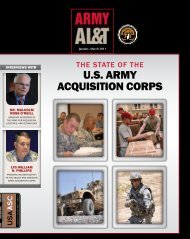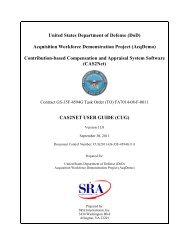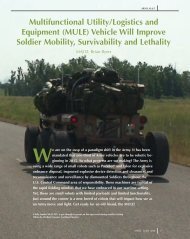Fire Suppression Systems (FSS) Enhance Tactical Wheeled Vehicle ...
Fire Suppression Systems (FSS) Enhance Tactical Wheeled Vehicle ...
Fire Suppression Systems (FSS) Enhance Tactical Wheeled Vehicle ...
Create successful ePaper yourself
Turn your PDF publications into a flip-book with our unique Google optimized e-Paper software.
army aL&T<br />
<strong>Fire</strong> <strong>Suppression</strong> <strong>Systems</strong> (<strong>FSS</strong>)<br />
<strong>Enhance</strong> <strong>Tactical</strong> <strong>Wheeled</strong> <strong>Vehicle</strong><br />
(TWV) Survivability<br />
COl michael receniello<br />
TWVs have been lost or rendered inoperable in iraq and afghanistan<br />
because of accidental vehicle fires or battle damage fires<br />
from ballistic attacks, including improvised explosive devices<br />
(ieDs) and ieD fragments. as a result, fire suppression experts from the<br />
army and U.S. Marine corps (USMc) have collaborated on providing<br />
numerous fSS to meet current and emerging threats.<br />
alpha co., 782nd Support Battalion MRaP vehicles are lined up in preparation to move out on a resupply mission in<br />
southern afghanistan. in the JUONS in fy05, the original fSS threshold requirement for the TWV fleet stated a need<br />
for hand-held, portable fire extinguishers. MRaPs were retrofitted and fielded with the initial fSS requirements after<br />
the initial TWVs. (U.S. air force photo by Sra Kenny Holston.)<br />
28 july –september 2010
the harsh operational environments<br />
in Iraq and Afghanistan place great<br />
stress on tWVs. Added stress on<br />
vehicle components can cause electrical<br />
malfunctions and fuel leaks, which<br />
could lead to accidental vehicle fires.<br />
Furthermore, enemy forces are employing<br />
combustible accelerants combined<br />
with IEDs, causing initial impact<br />
destruction, blast over-pressurization,<br />
and secondary fires.<br />
Various Fss are currently installed on<br />
fuel tank, tire, engine, and crew compartments<br />
of the Army and usmC<br />
tWV fleets. It is the responsibility of<br />
the services to ensure that the most<br />
survivable and supportable tWVs are<br />
fielded to warfighters. to do this, the<br />
Army and usmC conduct extensive<br />
market surveys and engineering studies<br />
to determine the most effective combinations<br />
of armor and fire protection for<br />
soldiers and marines, while maintaining<br />
the proper balance of mobility, operability,<br />
and sustainability of the tWVs.<br />
this comprehensive approach has<br />
identified that no single fire protection<br />
technology is appropriate for all<br />
vehicle applications, meaning Fss are<br />
tailored to the unique configurations<br />
of each tWV within their space and<br />
weight constraints. every tWV is<br />
equipped with one or more portable<br />
fire extinguishers.<br />
Evolution of Requirements<br />
Fss requirements for other vehicles in<br />
the tWV fleet stemmed from a joint<br />
urgent Operational Needs statement<br />
(juONs) in Fy05. the juONs did<br />
not initially include mine resistant<br />
Ambush protected (mrAp) vehicles,<br />
but targeted the Army and usmC<br />
tWV fleet. the original Fss threshold<br />
requirement for the tWV fleet stated a<br />
need for hand-held, portable fire extinguishers.<br />
the objective requirement was<br />
for internal (crew cab) automatic activated<br />
Fss with manual (activated by a<br />
press of a button), external (engine, tire,<br />
and fuel tank areas) fire extinguishers.<br />
After the initial tWVs (light, medium,<br />
and heavy), mrAps were retrofitted<br />
and fielded with the initial Fss requirements.<br />
the Army received additional<br />
ONs from the theater of operations<br />
fSS will ultimately reduce casualties, reduce vehicle losses, and better enable warfighters to complete their missions.<br />
(U.S. army photo.)<br />
army aL&T<br />
It is the responsibility of the services to ensure that the most<br />
survivable and supportable TWVs are fielded to warfighters.<br />
for automatic Fss capabilities on<br />
all tWVs following.<br />
the Army’s Fss requirements for<br />
up-armored tWVs came through<br />
various ONs received from Operations<br />
Enduring and Iraqi Freedom (OEF/<br />
OIF ), which were subsequently validated<br />
in August 2008. While these<br />
ONs identified the need for extinguishing<br />
fires on tWVs, they did not give<br />
specifics on what areas of the vehicles<br />
needed coverage or what type of system<br />
to use. the usmC’s Fss requirements<br />
for up-armored tWVs came through<br />
urgent universal Need statements,<br />
which reiterated the Army’s Fss<br />
requirements, with one exception that<br />
related to crew compartment fires.<br />
Off-Platform (Non-<strong>Vehicle</strong>)<br />
Solutions<br />
the Army’s product manager sets,<br />
Kits, Outfits, and tools (pm sKOt)<br />
began developing and fielding enhanced<br />
off-platform firefighting capabilities in<br />
December 2007. These<br />
systems help soldiers extinguish<br />
external vehicle fires<br />
caused by adverse action or<br />
maintenance-related failures.<br />
pm sKOt, under the<br />
leadership of the Army’s<br />
project manager joint<br />
Combat support systems,<br />
program executive Office<br />
Combat support and<br />
Combat service support<br />
(peO Cs&Css), issued<br />
17 soldier-portable<br />
firefighting sets, two<br />
trailer-mounted firefighting<br />
systems, and two refill<br />
kits to soldiers in theater.<br />
Army and usmC units in<br />
theater have procured additional<br />
portable firefighting<br />
july –september 2010<br />
29
army aL&T<br />
sets to supplement the vehicle Fss, to<br />
include a backpack with 5 gallons of<br />
water-based foam and a compressed air<br />
cylinder to fight external vehicle fires.<br />
The Future of <strong>FSS</strong><br />
peO Cs&Css, working alongside<br />
the U.S. Army Research, Development,<br />
and engineering Command, is advancing<br />
Fss technologies. research and<br />
development (R&D) initiatives are<br />
paving the way in evaluating emerging<br />
Fss technologies necessary to support<br />
the Army’s modernization plans for<br />
legacy vehicles, as well as developing<br />
and evaluating new fire protection<br />
technologies for future tWV applications.<br />
these include fuel tanks, crew<br />
automatic fire extinguishing systems<br />
(AFes), and Fss agents.<br />
technologies are being developed in the<br />
form of a self-sealing bladder fuel tank,<br />
which is designed to be crash-tolerant.<br />
the systems provide significant increases<br />
in survivability when subjected to ballistic<br />
impacts. Another technology prototype<br />
is the integral fuel tank. this protection<br />
is a combination of the powder panel<br />
and self-sealing coating concepts. these<br />
systems are designed to be internal to the<br />
fuel tank, protecting fuel tanks from<br />
explosions and external fires following<br />
the impact from various threats.<br />
In addition to fuel tank redesign and<br />
protection, the Army is investigating<br />
fire-resistant fuel (FrF) for ground<br />
The army’s fSS requirements for up-armored TWVs came through various<br />
ONS received from OEF/OIF, which were subsequently validated in<br />
august 2008. (U.S. army photo.)<br />
30 july –september 2010<br />
R&D initiatives are paving the way in evaluating emerging <strong>FSS</strong><br />
technologies necessary to support the Army’s modernization<br />
plans for legacy vehicles, as well as developing and evaluating<br />
new fire protection technologies for future TWV applications.<br />
vehicles. FrF is still under development<br />
for jp-8, and the logistics burdens<br />
associated with its fielding must be<br />
addressed before integration into the<br />
tWV fleet. FrF provides a safer, less<br />
flammable fuel to the warfighter. It is<br />
potentially compatible with all combat<br />
and tactical vehicles, but does cause a<br />
loss in vehicle power, torque, and range.<br />
An advanced crew AFes technology<br />
under development is ‘zero delay’<br />
activation. the principle behind this<br />
technology is to activate the crew AFes<br />
when the fuel tank is penetrated in a<br />
ballistic event, before a fire develops.<br />
the crew AFes will discharge before<br />
the fire fully develops. this concept has<br />
been tested with promising results, and<br />
additional development and test and<br />
evaluation (t&e) will be conducted<br />
to refine and verify the initial approach<br />
and assess the applicability to tWVs.<br />
Further t&e is being conducted to<br />
identify possible alternate extinguishing<br />
agents for legacy vehicles as well<br />
as future applications. this effort will<br />
enable the Army and<br />
usmC to evaluate<br />
more effective<br />
and environmentally<br />
friendly extinguishing<br />
agents than those<br />
currently used.<br />
the Fss procurement<br />
and integration<br />
plan must meet the<br />
Army long-term<br />
protection strategy of<br />
all tWVs and must<br />
be armor-capable.<br />
the protection offered by the Fss is<br />
critical to crew survivability in combat<br />
operations; it is treated with the<br />
same level of importance as external<br />
armoring of vehicles. priority of acquisition<br />
of the system must be given to<br />
tWVs in the Army Force Generation<br />
(ArFOrGeN) theater-provided<br />
equipment pool and preposition<br />
stocks, with second priority given to<br />
the tWV equipment requirements in<br />
the available pool. Additionally, certain<br />
tWVs in the ArFOrGeN train/<br />
ready/define/explain pool will require<br />
the Fss for training purposes.<br />
Future capability designs will require<br />
some type of Fss to mitigate risks.<br />
The U.S. Army Training and Doctrine<br />
Command and the usmC Combat<br />
Development Command, with the<br />
capabilities integration missions, will<br />
incorporate Fss capabilities into future<br />
requirements documents. today, Fss<br />
can be linked back to current ONs/<br />
juONs and will be integrated into<br />
future developments. Fss will ultimately<br />
reduce casualties, reduce vehicle<br />
losses, and better enable warfighters to<br />
complete their missions.<br />
COL MICHAEL RECENIELLO is<br />
the Deputy Program Executive Officer<br />
Cs&Css for Acquisition, logistics,<br />
and technology. He holds a b.s. in<br />
business administration and a b.A. in<br />
psychology from Columbia univeristy<br />
and an m.s. in operations research<br />
from st. louis university. receniello is<br />
certified level III in program management<br />
and contracting and level II in<br />
life-cycle logistics.


